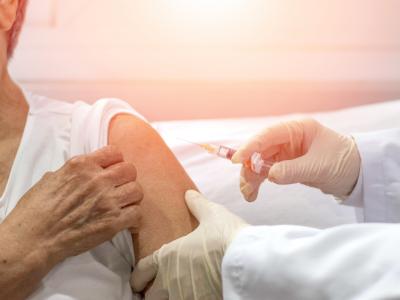Trial suggests shorter antibiotic course for hospitalized pneumonia
The results of a randomized clinical trial conducted in France indicate that 3 days of beta-lactam therapy is non-inferior to 8 days of treatment in patients hospitalized with community-acquired pneumonia who meet clinical stability criteria after 3 days, French investigators reported last week in The Lancet Infectious Diseases.
The Pneumonia Short Treatment (PTC) trial was conducted in 16 hospitals in France and involved non-immunocompromised adult patients admitted to the hospital with moderately severe community-acquired pneumonia who met prespecified clinical criteria after 3 days of treatment with beta-lactam therapy. The trial participants were randomly assigned to receive either 5 days of additional beta-lactam therapy (oral amoxicillin plus clavulanate) or 5 days of placebo, with participants, clinicians, and study staff blinded to treatment allocation. The primary outcome was cure 15 days after first antibiotic intake, with a non-inferiority margin of 10 percentage points.
From December 2013 to February 2018, 310 eligible patients were assigned to receive placebo (157) or beta-lactam treatment (153). Seven patients withdrew consent before treatment started. In the intention-to-treat analysis (ITT), cure at day 15 occurred in 117 of 152 patients (77%) in the placebo group and 1o2 of 151 (68%) in the beta-lactam group (between-group difference, 9.42 percentage points; 95% confidence interval [CI], -0.38 to 20.04), indicating non-inferiority.
Results of the per protocol analysis also indicated non-inferiority, with 113 of 145 placebo patients (78%) and 100 of 146 in the beta-lactam group (68%) cured at day 15 (between-group difference, 9.44 percentage points; 95% CI, -0.15 to 20.34). Incidence of adverse events was similar in the placebo group (11%) and the beta-lactam group (19%). By day 30, 3 patients (2%) in the placebo group and 2 (1%) in the beta-lactam group died.
"These data support the concept that antibiotic therapy can be safely discontinued in patients who have moderately severe community-acquired pneumonia who have early clinical response to therapy, which could allow an important reduction in antibiotic exposure among patients being treated in hospital for community-acquired pneumonia," the authors wrote.
Mar 25 Lancet Infect Dis abstract
Report highlights R&D, access gap for pediatric drugs
A new report from the Access to Medicine Foundation finds significant gaps in treatments aimed specifically at children under 12, highlighted by a lack of access to a child-friendly Clostridioides difficile treatment and a dearth of drugs that address diarrheal diseases in infants in low- and middle-income countries (LMICs).
According to the report, among the five treatments that could be "game-changers" for children in LMICs is an oral suspension of fidaxomicin for C difficile-associated diarrhea in children over 6 months of age. The treatment, developed by MSD and Astellas Pharma Europe, was approved by the US Food and Drug Administration in 2o20 but does not show any evidence of an access plan that would help ensure it is accessible and affordable in all the markets where it's needed.
The report shows that of the 1,073 pharmaceutical research and development (R&D) projects assessed, less than 7% (69) target children under the age of 12 and are focused mainly on lower respiratory infections, cancer, HIV/AIDS. Only five projects target neonatal sepsis, and the pipeline for certain diarrheal infections such as Escherichia coli and cholera is completely empty, despite being identified as a priority R&D target by the World Health Organization.
The authors of the report suggest that stakeholders can address these gaps by simplifying regulatory procedures for pediatric drugs, establishing targeted economic incentives to encourage pediatric R&D, integrating access plans into the R&D process, and increasing funding for innovative approaches to expanding access to pediatric drugs in LMICs.
"For the millions of children waiting in line for medicines that are taken for granted in high-income countries, it is not enough that a few projects are in development," the report states. "It is not enough that a few more mechanisms are in place to ensure some of these projects will reach children who need them. It is time to close the gaping disparities in access that persist."
Mar 25 Access to Medicine Foundation report
Spanish stewardship intervention linked to reduced carbapenem use
A multifaceted antimicrobial stewardship program (ASP) was associated with reduced carbapenem use and decreased incidence of carbapenem-resistant Acinetobacter baumannii, according to a study last week in the Journal of Antimicrobial Chemotherapy.
The quasi-experimental time-series study involved seven hospitals in Andalusia, Spain, with carbapenem use above the region's average. A team of Spanish researchers looked at carbapenem use and identification of carbapenem-resistant gram-negative bacilli (CR-GNB) from January 2014 through September 2018, comparing the 11 quarters prior to the introduction of the ASP with the 8 quarters after.
The ASP intervention had four components addressing carbapenem prescribing, with the core activity being educational interviews between stewardship teams and prescribing physicians after they prescribed carbapenems. During the intervention period, 6,046 interviews on antibiotic prescriptions were carried out, and 1,747 involved carbapenem prescriptions.
The use of carbapenems decreased throughout the study period (average quarterly percentage change [AQPC], -1.5%), with a level change of -8.170 observed following the start of the intervention. The total number of educational interviews per hospital was correlated with a decrease in carbapenem use. While the overall incidence density (ID) of CR-GNB remained stable during the study period (AQPC, -0.4%), the ID of CR-A baumannii decreased (AQPC, -3.5%). CR-GNB, CR-A baumannii, and CR-Pseudomonas aeruginosa IDs per hospital correlated with the local consumption of carbapenems.
The study authors note that the reduced consumption of carbapenems was achieved without adopting restrictive measures, using educational interventions only, and despite a shortage of piperacillin/tazobactam, which increased carbapenem use in the third quarter of 2017.
Mar 26 J Antimicrob Chemother abstract












